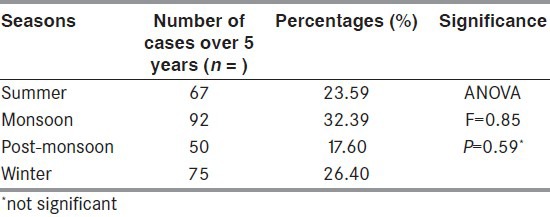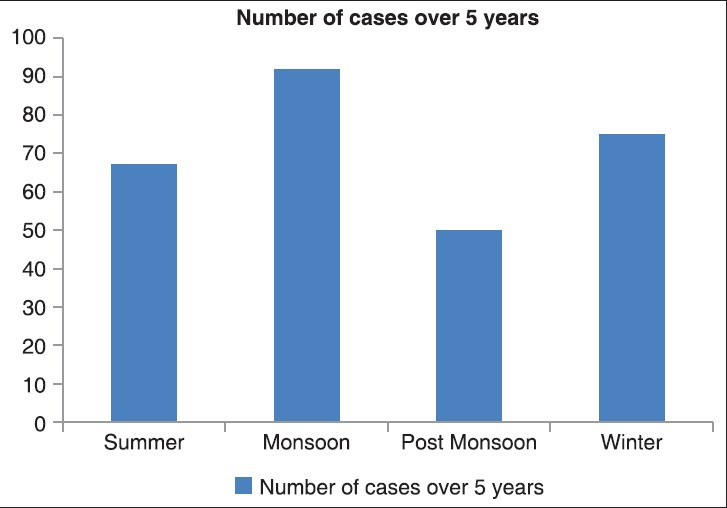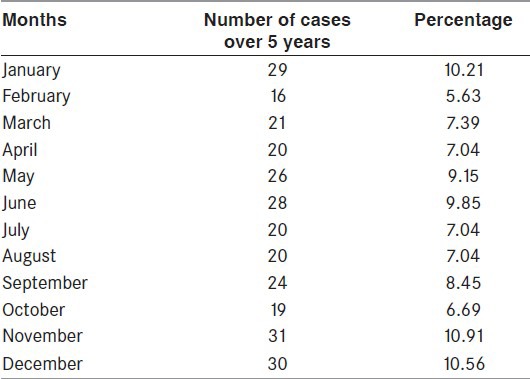Sir,
Seasonal variations have not been adequately studied in Guillain-Barre Syndrome (GBS). During our clinical practice, it was observed that there was clustering in the occurrence of GBS during certain seasons and months of the year. We did a retrospective study in our institute, a tertiary care center in South India from June 2008 to May 2013, in the departments of Neurology, Medicine, and Pediatrics to analyze the monthly and seasonal occurrence of GBS. The outpatient and inpatient records of all patients who had presented to our hospital with symptoms of acute flaccid paralysis were reviewed retrospectively from June 2008 to May 2013 with special attention to the time of occurrence with respect to month and season. A diagnosis of GBS was made when the clinical features, electrophysiological findings, and CSF parameters satisfied the Asbury and Cornblath diagnostic criteria.[1] Patients with other causes of acute flaccid quadriparesis like acute transverse myelitis, hypokalemic paralysis, polymyositis, and myasthenia gravis were excluded. The seasons in India were divided as: Summer: March to May; Monsoon: June to September; Post-Monsoon: October to November: Winter: December to February according to the seasonal classification of Indian Meteorological Department.[2]
During the 5-year period, there were a total of 284 patients diagnosed with GBS. The male to female ratio was 1.7:1 (males: 179, females: 105), with age of onset from 5 months to 85 years.
The highest incidence of GBS was seen in the monsoon (n = 92, 32.39%) and winter (n = 75, 26.40%). There were 67 (23.59%) cases in summer and 50 (17.60%) cases in post-Monsoon [Table 1, Figure 1]. The monthly incidences of the disease were significantly high during January (10.21%), May (9.15%), June (9.85%), November (10.91%), and December (10.56%) [Table 2].
Table 1.
Seasonal trends over a 5-year period

Figure 1.

Seasonal trends over 5-year period
Table 2.
Monthly trends in the distribution Guillain Barre syndrome over a 5-year period

This observation can be attributed to the fact that the major preceding infections like gastroenteritis[3,4,5] and Influenza[6] tend to occur during these seasons and hence increasing the risk of acquiring GBS. The seasonal epidemiology of Campylobacter jejuni gastroenteritis has been studied in different regions of India, and a significant seasonal and monthly incidence have also been shown. The seasonality of Campylobacter species has been studied by Singh et al.,[7] which showed the highest prevalence of C. jejuni in the fecal samples during the rainy seasons and in the month of September.
Similar results were observed season-wise in a study from Pune by Saba et al.,[8] which showed a dual peak in the month of May and October. Studies from in and around Delhi showed influenza virus circulation peaks coincided with rainy and winter seasons.[9] A recent study from South India, which observed the seasonal variation in the clinical recovery of patients with GBS requiring mechanical ventilation, showed increase occurrence of GBS during the months of June to August and December to February, which is consistent with our seasonal and monthly peaks.[10] A comparison of the seasonal trends reported from various Indian studies is given in Table 3.
Table 3.
Seasonal trends from different Indian studies

The main highlight and purpose of undertaking this study is to create public awareness among individuals, families, and the government to be prepared round the year for the treatment and management of GBS, especially during monsoon and winter seasons. However, to strengthen this observation, further large multi-centric studies have to be done in future. To have a country wide registry of GBS would be an ideal step forwards, in knowing the incidence, prevalence, and seasonal trends of GBS.
References
- 1.Asbury AK, Cornblath DR. Assessment of current diagnostic criteria for Guillain-Barré syndrome. Ann Neurol. 1990;27(Suppl):S21–4. doi: 10.1002/ana.410270707. [DOI] [PubMed] [Google Scholar]
- 2.Toman MA, Chakravorty U, Gupta S. Washington, DC: RFF Press; 2003. India and Global Climate Change: Perspectives on Economics and Policy from a Developing Country, Resources for the Future Press. [Google Scholar]
- 3.The prognosis and main prognostic indicators of Guillain-Barré syndrome. A multi — centre prospective study of 297 patients. The Italian Guillain-Barré Study Group. Brain. 1996;119:2053–61. [PubMed] [Google Scholar]
- 4.Hadden RD, Karch H, Hartung HP, Zielasek J, Weissbrich B, Schubert J, et al. Plasma Exchange/Sandoglobulin Guillain-Barré Syndrome Trial Group. Preceding infections, immune factors, and outcome in Guillain-Barrésyndrome. Neurology. 2001;56:758–65. doi: 10.1212/wnl.56.6.758. [DOI] [PubMed] [Google Scholar]
- 5.Jackson BR, Zegarra JA, López-Gatell H, Sejvar J, Arzate F, Waterman S, et al. Binational outbreak of Guillain-Barré syndrome associated with Campylobacter jejuni infection, Mexico and USA, 2011. Epidemiol Infect. 2013:1–11. doi: 10.1017/S0950268813001908. [DOI] [PMC free article] [PubMed] [Google Scholar]
- 6.Greene SK, Rett MD, Vellozzi C, Li L, Kulldorff M, Marcy SM, et al. Guillain-Barré syndrome, influenza vaccination, and antecedent respiratory and gastrointestinal infections: A case-centered analysis in the vaccine safety datalink, 2009-2011. PLoS One. 2013;8:e67185. doi: 10.1371/journal.pone.0067185. [DOI] [PMC free article] [PubMed] [Google Scholar]
- 7.Singh R, Singh PP, Rathore RS, Dhama K, Malik SV. Studies on effect of seasonal variations on the prevalence of Campylobacter jejuni in poultry faecal samples collected from Western Uttar Pradesh. India J Comp Microbiol Immunol Infect Dis. 2008;29:45–8. [Google Scholar]
- 8.Parkar SFD, Sachdev D, deSouza N, Kamble A, Suresh G, Munot H, et al. Prevalence, seasonality and antibiotic susceptibility of thermophilic Campylobacters in ceca and carcasses of poultry birds in the “live-bird market”. AfrJ Microbiol Res. 2013;7:2442–53. [Google Scholar]
- 9.Broor S, Krishnan A, Roy DS, Dhakad S, Kaushik S, Mir MA, et al. Dynamic patterns of circulating seasonal and pandemic A (H1N1)pdm09 influenza viruses from 2007-2010 in and around Delhi, India. PLoS One. 2012;7:e29129. doi: 10.1371/journal.pone.0029129. [DOI] [PMC free article] [PubMed] [Google Scholar]
- 10.Sriganesh K, Netto A, Kulkarni GB, Taly AB, Umamaheswara Rao GS. Seasonal variation in the clinical recovery of patients with Guillain Barré syndrome requiring mechanical ventilation. Neurol India. 2013;61:349–54. doi: 10.4103/0028-3886.117582. [DOI] [PubMed] [Google Scholar]
- 11.Sharma G, Sood S, Sharma S. Seasonal, age and gender variation of Guillain Barre syndrome in a tertiary referral center in India. Neurosci Med. 2013;4:23–8. [Google Scholar]


